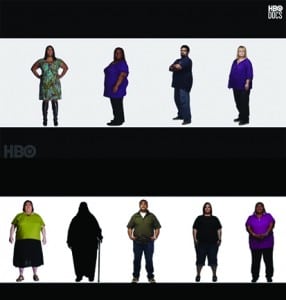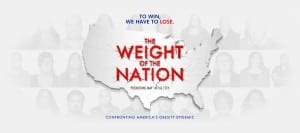In March 2010, Dinah Dittman, national director of community engagement and philanthropy for Kaiser Permanente, and Ray Baxter, senior VP for community benefit, research and health policy, attended the Center for Corporate Citizenship’s annual conference in Boston. One of the keynote speakers was John Hoffman, from HBO Documentary Films, who discussed his latest endeavor, The Alzheimer’s Project, and the impact of using television documentary films to reach audiences and support health knowledge.
During a Q&A session following the keynote Hoffman mentioned that his next project would focus on obesity, stressing that the stories in the film(s) weren’t sensationalized but, rather, told the story of how this problem developed in the United States, and what could be done to reverse the trend.
After the Q&A Baxter introduced himself to Hoffman, saying that Kaiser Permanente knew and cared a lot about obesity prevention, and would be interested in learning more about the project.
Fast Forward to May 2012, and the launch of The Weight of the Nation, a four-part documentary series and public health campaign designed to educate the public about the severity of the obesity epidemic and its crippling effects on the U.S. health care system.
The documentary series is a partnership among HBO, which produced the series, Kaiser Permanente, the Institute of Medicine, the Centers for Disease Control and Prevention (CDC), the National Institutes of Health (NIH) and The Michael & Susan Dell Foundation.
The four feature films premiered on HBO and, following the broadcast, were made available free of charge via the campaign’s website (theweightofthenation.hbo.com).
All told, the film provides a sobering look at myriad problems stemming from the obesity epidemic, primarily the fear among some medical experts that this is the first generation of American children who will have a shorter life expectancy than their parents.
Fixing these problems will be a Herculean task. More than one-third of adults (35%) and approximately 17% of children and adolescents are obese, according to the CDC, which reviewed all the obese-related materials discussed in the films to ensure their scientific accuracy.
With The Weight of the Nation documentary as its anchor, the PR campaign set out the following goals:

• Aim to accelerate efforts and help shift behaviors to prevent and eliminate obesity across the U.S.
• Create more awareness about obesity and have the film serve as a vehicle for sparking efforts nationwide to combat the obesity problem.
MULTIPLE PURPOSES
“The scope of producing the documentary and the rollout was a massive undertaking and involved many partners and stakeholders,” said Susannah Patton, communications manager/national media and PR brand communication for Kaiser Permanente, the nation’s largest nonprofit health care company, with 8.9 million members.
The company hosted and facilitated screenings throughout the country; some of the screenings were official while others were sparked by the distribution of a screening kit sent via the mail.
(The campaign’s website includes a separate page showing how people can request a screening kit, submit their screening on the calendar and download discussion guides featuring tips on a having a successful screening.)
The film has been presented at dozens of venues encompassing a diverse range of communities, such as the American Academy of Pediatrics Conference, California State University, Fresno and VivaFest Mexican Heritage & Mariachi Festival.
The campaign also did outreach to medical organizations, along with a major push at middle schools and high schools. “It’s not just a documentary you watch,” Patton said. “It becomes a tool for discussion to spark change within your community.”

LOCAL STRATEGY
A key part of the communications strategy has been to work with regional and local PR teams to publicize the screenings because that’s the most effective way to spread the word, in terms of encouraging PR pros to harness existing relationships with local media reps.
Kaiser also helped to promote the screenings and public health campaign through multiple social media platforms, including a Facebook page and Twitter account, along with two separate TweetChats.
An email outreach was distributed to about 7,500 of Kaiser Permanente’s insurance brokers in California while an article about the Kaiser Permanente partnership, that ran in Health magazine, was mailed to 1.5 million members.
Kaiser Permanente also mounted a comprehensive employee communications campaign to encourage its 174,000 workers to have their own screenings.
Screening kits were also distributed to several of Kaiser Permanent’s national accounts, such as American Airlines, Anheuser Busch, and the Lockheed Martin Corp.
Another PR component: Pitch health care bloggers and influencers active in combating obesity and supply them with anti-obesity materials that they could, in turn, distribute to their audiences.
THE RESULTS
The screenings were a major hit; in 2012 nearly 9,000 people attending HBO and Kaiser Permanente screenings throughout the country. The documentary also got the nod for two Emmy nominations.
Here are some of the other metrics from the campaign:
• 6.2 million people viewed the films on HBO platforms when they launched in May 2012.
• The four full episodes were streamed 2 million times.
• To date, there have been more than 400 positive stories about Kaiser Permanente and The Weight of the Nation campaign.
• The Weight of the Nation Facebook posts have garnered nearly 99,000 views.
• The official hashtag for The Weight of the Nation created 57 million impressions.
“The metrics speak for themselves,” Patton said. “We were able to make sure that people—both externally and internally—saw the documentary, joined the discussion [about obesity] and engaged the campaign via social media.” PRN
CONTACT:
Susannah Patton, [email protected].
Taking a Shot at Long-Form Video Programming
With the explosion in short-form social video, it would be easy to write off documentary films as an effective platform for telling important stories. At Kaiser Permanente, however, we have embraced the long-form video programming, with great results.
The Weight of the Nation is a good example. This collaboration resulted in four, hour-long documentary films and three additional 30-minute films targeted at youths. The films are just one part of a public health campaign aimed at fighting obesity. We are continuing to see the value of these powerful documentary films as they are screened across the country and discussion remains active throughout social channels.
More recently, we witnessed the power of documentary film after the launch of The Walking Revolution, produced by Every Body Walk!, a campaign powered by Kaiser Permanente aimed at getting Americans up and moving. After its launch, on October. 17, 60,000 people viewed the 30-minute film online in the first month. And while we also produced an 8-minute trailer, 90% of viewers opted to watch the entire film
As with The Weight of the Nation, our experience with The Walking Revolution has confirmed both the value of forming partnerships with like-minded organizations and producing long form video programming to help spread the message. With that in mind, here are a few tips for leveraging documentary film and long-form video:
▶ Form partnerships and develop relationships with like-minded organizations. With the “Walking Revolution,” we have received interest from several national organizations that will help us spread the word and organize screenings across the country.
▶ Create shorter clips and shorts, but release the long version first. Don’t underestimate appetite for the long version. You might be surprised by how many people will want to watch the entire documentary.
▶ Schedule screening events well around the film launch, but also beyond that time. A well-produced film that delves into important topics will live on well into the future.
Susannah Patton is communications manager/national media and PR brand communication at Kaiser Permanente.
This article originally appeared in the Jan. 6, 2014 issue of PR News.

